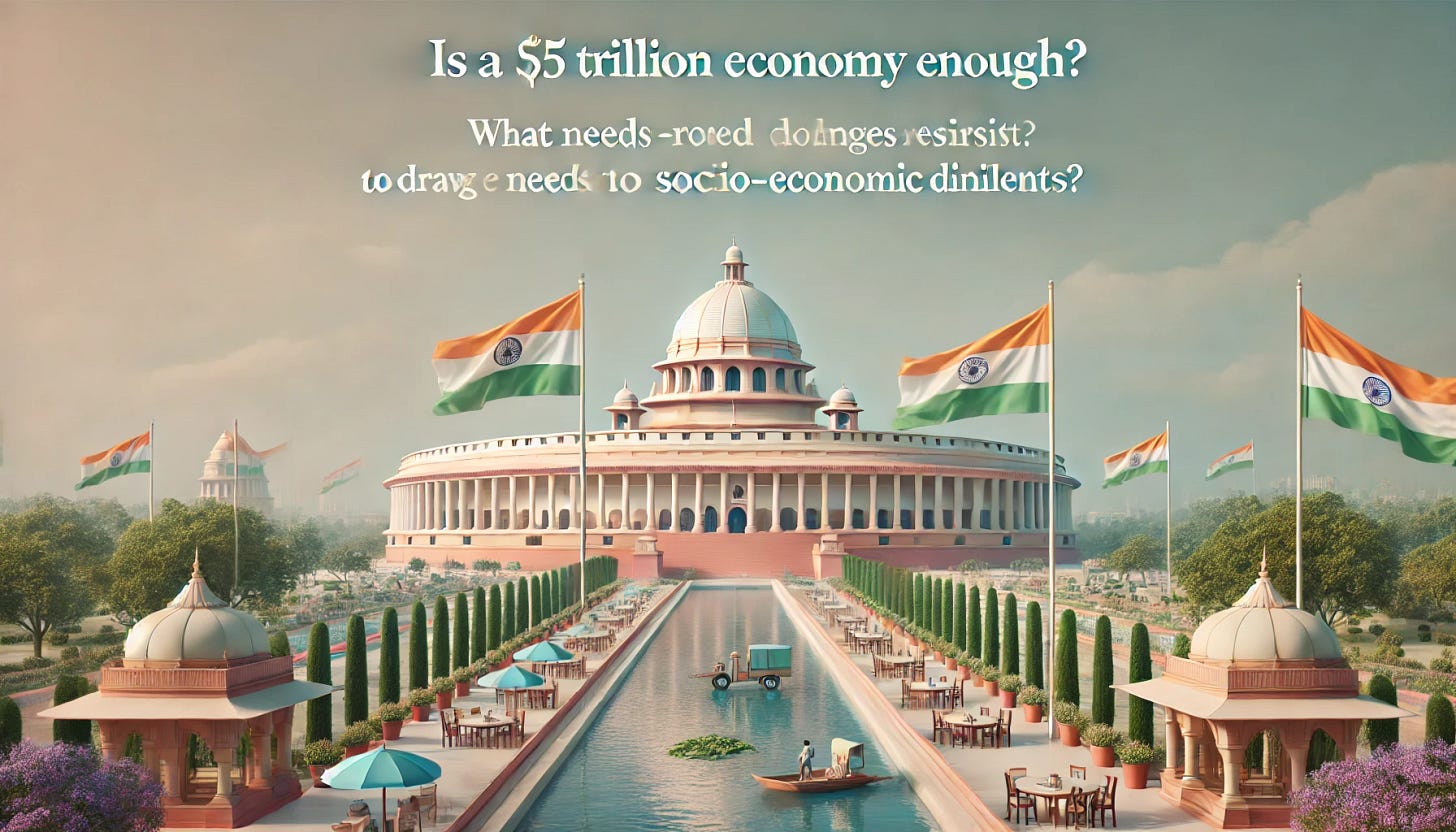India: Is a $5 Trillion Economy Alone Enough?
Is a $5 Trillion Economy Enough? India's Deep-Rooted Challenges Persist. What Needs to Be Done to Draw Optimal Socio-Economic Dividends?
Is a $5 Trillion Economy Enough?
While India's aspirational ascent to a $5 trillion economy is indeed an ambitious and remarkable milestone, this achievement alone may not be sufficient to address the country's deep-rooted socio-economic challenges. Behind the veneer of this impressive GDP figure, India continues to grapple with stark income inequality, high unemployment, inadequate health and education infrastructure, rural distress, and a regressive taxation system. As promised, we present this follow-up article to our previous one captioned "India, a $5 Trillion Economy: Why It Matters?"
a.) Skewed Distribution of Wealth and Income
One of the most glaring issues is the highly skewed distribution of wealth and income in India. According to the World Inequality Report 2022, India's top 10% holds 57% of the total national income, while the bottom 50%'s share has gone down to 13%. The affluence of the elite few stands in sharp contrast to the plight of marginalized communities, particularly the Scheduled Castes (SCs), Scheduled Tribes (STs), and certain minority communities. The concentration of wealth in the hands of the top 1% has further widened this chasm, exacerbating social and economic disparities.
b.) Persistent Unemployment
Despite India's economic growth, the specter of unemployment looms large, especially among the educated youth. As per CMIE data, the unemployment rate in India stood at 7.45% in February 2024, with urban unemployment at 8.55% and rural at 6.88%. Industry leaders often lament the lack of requisite skills among job seekers, while the advent of artificial intelligence threatens to displace even skilled and semi-skilled workers in the software sector. The government's investments in sectors like microchip manufacturing, while crucial, may not generate significant employment opportunities.
c.) Inadequate Health and Education Infrastructure
The state of health and education infrastructure in India remains abysmal at all levels - primary, secondary, and tertiary. India's public health expenditure is a mere 1.28% of its GDP (2019-20), far below the global average of 6%. Recent incidents like the NEET exam leakage and UGC-NET cancellation have sparked discontent and frustration among students. The controversial "Agniveer" scheme for military recruitment has also faced criticism for its short-term contract model.
d.) Rising Inflation and Rural Distress
Rising inflation and high cost of living have further compounded the woes of the common people. As per RBI data, CPI inflation stood at 6.52% in January 2024, breaching the upper tolerance limit. The fact that 80 crore out of India's 1.4 billion population rely on free food grain distribution by the government raises serious questions about the nature and inclusivity of the country's economic growth. The agricultural sector, which employs over 40% of the workforce, is plagued by rural distress, unremunerative crop prices, indebtedness, and farmer suicides.
e.) Regressive Taxation Policies
India's taxation policies, particularly the Goods and Services Tax (GST) regime, have come under scrutiny for their regressive nature. While GST collections hit a record high of Rs 1.55 lakh crore in January 2024, this indirect tax places a disproportionate burden on the low and middle-income groups. The disparity in income tax rates, where companies enjoy lower rates (22%) than individuals in the highest tax bracket (30%, before cesses), further underscores the skewed nature of the tax system.
Fiscal Management and Priorities in the Budget
The Indian Government's Budget for the fiscal year 2024-25 presents a mixed picture in terms of fiscal management and developmental priorities. The fiscal deficit, estimated at 5.1% of GDP, and the revenue deficit, pegged at 2% of GDP, remain significant concerns. A substantial portion of the Budget is committed to obligatory expenditures such as salaries, pensions, debt servicing, and defence, leaving limited room for maneuver. Moreover, the allocation for food and fertilizer subsidies, though lower than the previous year, still constitutes a considerable burden on the exchequer. While the government has marginally increased the outlay for health and education, these critical sectors demand a much larger share of resources to build human capital and drive inclusive growth.
Limited Outlay for Capital Investment
Consequently, the allocation for capital expenditure, which is crucial for infrastructure development and long-term economic growth, remains constrained. As India aspires to become a $5 trillion economy, it is imperative to reorient is central Budget towards productive investments in physical and social infrastructure. This requires a concerted effort to rationalize subsidies, expand the tax base, improve tax compliance, and explore innovative financing mechanisms, especially in the PPP mode. Only by striking a delicate balance between fiscal prudence and growth-enhancing expenditure can India fully capitalize on the opportunities presented by its economic ascent to a 5 trillion dollar economy.
Centralization Concerns in India's Fiscal Federalism
India's journey towards a $5 trillion economy is marked by significant changes in fiscal federalism, yet centralization concerns persist. Over the successive Central Finance Commissions, the share of cesses and surcharges in central tax revenues has nearly doubled, reducing the tax pool shared with states. Centrally Sponsored Schemes (CSS) funding has increased by 144%, while untied state funds grew by only 61%, constraining states' fiscal autonomy. The end of GST compensation in June 2022 has exacerbated revenue shortfalls, and despite constitutional amendments, the transfer of funds, functions, and functionaries to local bodies remains inadequate.
Devolution to the Third Tier
Horizontal imbalances between states persist, with substantial differences in per capita GSDP. To address these issues, experts recommend expanding the divisible pool, rationalizing CSS, extending GST compensation, incentivizing state-level devolution, revisiting devolution criteria, allowing states to levy income taxes, and institutionalizing cooperative federalism bodies. Additionally, true devolution and delegation to Panchayati Raj Institutions (PRIs) and Urban Local Bodies (ULBs) beyond the state level, in accordance with the letter and spirit of the Constitution, is necessary to ensure genuine "power to the people." Comprehensive reforms are essential to empower all government levels, ensuring equitable growth as India aims for a $5 trillion economy.
Summing Up and Looking Ahead
While aspring to achieve a $5 trillion economy is undoubtedly a laudable objective, it is not a panacea for India's deeply entrenched socio-economic problems. Unless concerted efforts are made to address income inequality, generate employment, improve health and education facilities, alleviate rural distress, and reform the taxation structure, the benefits of this economic milestone may not trickle down to the masses. The government must prioritize inclusive growth and social welfare to ensure that India's economic prosperity is shared by all, not just a privileged few.
Additionally, budgetary priorities and reforms should focus on devolving more powers and resources to the states and the third tier of governance, in line with the letter and spirit of the Constitution. This includes empowering Panchayati Raj Institutions (PRIs) and Urban Local Bodies (ULBs) and keeping the citizen at the center of the development discourse. Failure to address these issues may lead to widespread discontent, particularly among the educated unemployed youth (estimated at 35 million) and the struggling agricultural sector, against the backdrop of rising living costs and stagnant wages.
If you believe this article would interest someone you know, please feel free to share it anonymously (for us), using any platform that you prefer.






